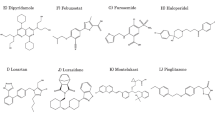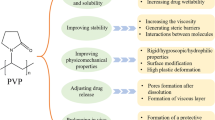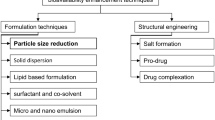Abstract
The aim of the investigation was to develop and optimize the effervescent floating matrix tablets of Quetiapine Fumarate (QF) by using 23 factorial design. Amount of hydroxyl propyl methyl cellulose K4M (HPMC K4M (A1)), amount of hydroxyl propyl methyl cellulose K15M (HPMC K15M (A2)) and amount of sodium bicarbonate (A3) (as gas-generating agent) were considered as independent variables and floating lag time (FLT, B1) (sec), percent drug release in 2 h (B2, Q2) and 6 h (B3, Q6) as dependent variables, respectively. Floating tablets of QF were prepared by effervescent technique using direct compression method. Drug-excipient compatibility studies were conducted by using DSC and FTIR techniques. The floating tablets were evaluated for physical characteristics, drug content, swelling index, in vitro buoyancy and in vitro release studies. Optimized formulation contains 25 mg of A1, 12.5 mg of A2 and 25 mg of A3 which resulted in 32 s of B1, 32.89 ± 3.1 % of B2, and 73.61 ± 1.8 % of B3, respectively. DSC and FTIR studies revealed that no interaction between the drug and excipients in the developed formulation. The drug release followed Higuchi model and the Fickian transport. Physico-chemical stability studies revealed that the optimized formulation was stable for 90 days. Based on the physical evaluation and in vitro drug release characteristics, it was concluded that QF was suitable for incorporation into a floating drug delivery system.





Similar content being viewed by others
References
Araujo PW, Brereton RG (1996) Experimental design 1, screening. Trends Anal Chem 15:26–31
Arora S, Ali J, Ahuja A, Khar RK, Baboota S (2005) Floating drug delivery systems: a review. AAPS Pharm Sci Tech 6(3):372–390
Basak SC, Rahman J, Ramalingam M (2007) Design and in vitro testing of a floatable gastroretentive tablet of metformin hydrochloride. Pharmazie 60(2):145–148
Baumgartner S, Kristi J, Vrecer F, Vodopivec P, Zorko B (2000) Optimization of floating matrix tablets and evaluation of their gastric residence time. Int J Pharm 195:125–135
Box GE, Hunter WG, Hunter JS (2005) Statistics for experimenters: design, innovation, and discovery, 2nd edn. Wiley, New York. ISBN ISBN 978-0-471-71813-0
Bui K, Earley W, Nyberg S (2013) Pharmacokinetic profile of the extended-release formulation of quetiapine fumarate (quetiapine XR): clinical implications. Curr Med Res Opin 29(7):813–825
Chavanpatil M, Jain P, Chandhari S, Shear R, Vavia P (2005) Development of sustained release gastroretentive drug delivery system for ofloxacin: in vitro and in vivo evaluation. Int J Pharm 304:178–184
Chawla G, Bansal A (2003) A means to address regional variability in intestinal drug absorption. Pharm Technol 27:50–68
Davis SS, Stockwell AF, Taylor MJ (1986) The effect of density on the gastric emptying of single and multiple unit dosage forms. Pharm Res 3:208–213
Deshpande AA, Rhodes CT, Shah NH, Malick AW (1996) Controlled-release drug delivery systems for prolonged gastric residence: an overview. Drug Dev Ind Pharm 22:531–539
Deshpande AA, Shah NH, Rhodes CT, Malick W (1997) Development of a novel controlled-release system for gastric retention. Pharm Res 14:815–819
Doodipala N, Palem RC, Reddy S, Rao Y (2011) Pharmaceutical development and clinical pharmacokinetic evaluation of gastroretentive floating matrix tablets of levofloxacin. Int J Pharm Sci Nanotech 4:1463–1469
Fisher R (1926) The arrangement of field experiments (PDF). J Minist Agric Great Br 33:503–513
Garg R, Gupta GD (2009) Preparation and evaluation of gastro retentive floating tablets of acyclovir. Curr Drug Deliv 6(5):437–443
Hadi MA, Babu VL, Pal N (2012) Formulation and evaluation of sustained release matrix tablets of glimepiride based on combination of hydrophilic and hydrophobic polymers. J Appl Pharm Sci 2:101–107
Higuchi T (1963) Mechanism of sustained action medication. Theoretical analysis of rate of release of solid drugs dispersed in solid matrices. J Pharm Sci 52:1145–1148
Iannuccelli V, Coppi G, Bernabei MT, Cameroni R (1998) Air compartment multiple unit system for prolonged gastric residence. Part I. Formulation study. Intl J Pharm 174:47–54
Korsmeyer R, Gurny R, Peppas N (1983) Mechanisms of solute release from porous hydrophilic polymers. Int J Pharm 15:25–35
Menon A, Ritschel WA, Sakr A (1994) Development and evaluation of a monolithic floating dosage form for furosemide. J Pharm Sci 83:239–245
Narendar Reddy D, Chinna Reddy P, Sunil R, Madhusudan Rao Y (2012) Development of floating matrix tablets of Ofloxacin and Ornidazole in combined dosage form: in vitro and in vivo evaluation in healthy human volunteers. Int J Drug Del 4(4):462–469
Peppas NA (1985) Analysis of Fickian and non-Fickian drug release from polymers. Pharm Acta Helv 60:110–111
Rosa M, Zia H, Rhodes T (1994) Dosing and in vitro testing of a bioadhesive and floating drug delivery system for oral application. Int J Pharm 105:65–70
Santus G, Lazzarini G, Bottoni G et al (1997) An in vitro-in vivo investigation of oral bioadhesive controlled release furosemide formulations. Eur J Pharm Biopharm 44:39–52
Sudhalakshmi P, Vardhan SVM, Ramachandran D, Rambabu C (2009) UV spectrophotometric determination of quetiapine and zonisamide. Asian J Chem 21(1):811–813
Wagner JG (1969) Interpretation of percent dissolved-time plots derived from in vitro testing of conventional tablets and capsules. J Pharm Sci 58:1253–1257
Whitehead L, Fell JT, Collett JH, Sharma HL, Smith AM (1998) Floating dosage forms: an in vivo study demonstrating prolonged gastric retention. J Control Rel 55:3–12
Acknowledgments
The authors acknowledge M/s Hetero Drugs Ltd., Hyderabad, India for providing drug. One of the authors (Someshwar. K) thanks AICTE, New Delhi for providing fellowship to carry out this research work.
Declaration of interest
Authors declare that no conflict of interest is there in this study.
Author information
Authors and Affiliations
Rights and permissions
About this article
Cite this article
Narendar, D., Arjun, N., Someshwar, K. et al. Quality by design approach for development and optimization of Quetiapine Fumarate effervescent floating matrix tablets for improved oral bioavailability. Journal of Pharmaceutical Investigation 46, 253–263 (2016). https://doi.org/10.1007/s40005-016-0232-5
Received:
Accepted:
Published:
Issue Date:
DOI: https://doi.org/10.1007/s40005-016-0232-5




